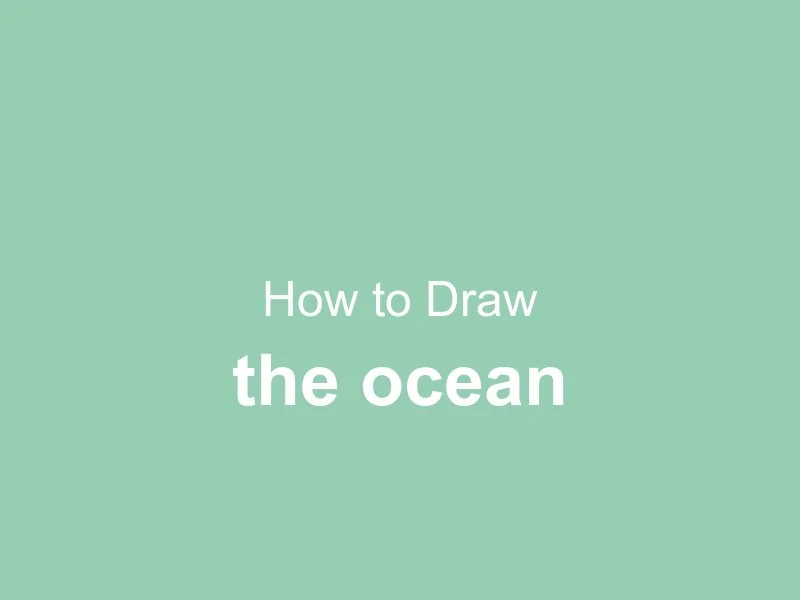How to Draw the Ocean
Learn how to draw the ocean with this step-by-step guide.

Materials You'll Need
- Drawing paper
- Pencil (HB or 2B)
- Eraser

The ocean is a vast, ever-changing masterpiece, full of movement, depth, and tranquility. Whether you want to capture the calm, glassy surface of a peaceful sea, the dramatic motion of crashing waves, or the soft ripples of a shoreline, learning how to draw the ocean is both a challenging and rewarding artistic endeavor.
In this step-by-step guide, we'll break down the process of drawing the ocean—starting with its basic structure and wave patterns, then refining light reflections, shading techniques, and intricate water details. By the end of this tutorial, you'll have the skills to create stunning ocean scenes, bringing the depth, motion, and beauty of the sea to life on your canvas.
So, grab your pencils, erasers, and blending tools, and let's dive into the art of ocean drawing!
Materials Required
Before we begin, let's gather the materials you will need for this drawing tutorial:
Now that we have our materials ready, let's dive into the process of drawing the ocean!
Step 1: Sketch the Horizon Line
Start by lightly sketching a straight line across your paper to represent the horizon. This line will help us maintain a consistent perspective throughout the drawing.
Step 2: Create the Basic Shape of the Waves
Using curved lines, sketch the basic outline of the waves. Remember, waves are not uniform, so play around with different shapes and sizes to create a realistic ocean surface. Don't worry about adding too much detail at this stage, as we will be refining the waves later.
Step 3: Add Depth to the Waves
To give the waves depth and dimension, add contour lines inside the wave shapes. These lines will represent the overlapping and folding of the waves, creating a sense of movement and volume.
Step 4: Refine the Wave Shapes
Now it's time to refine the shapes of the waves. Take your pencil and carefully observe the reference images or your imagination. Pay attention to how the waves curve, crest, and break. Use short, curved lines to add more definition to the waves, capturing their dynamic nature.
Step 5: Shade the Waves
To add realism to your ocean drawing, we need to shade the waves. Begin by determining the direction of light in your scene. Then, using a light shading technique, start shading the areas of the waves that are facing away from the light source. Gradually build up the shading to create a smooth transition from light to dark.
Step 6: Add Foam and Spray
Waves often create foam and spray as they crash against the shoreline or other objects. Use your pencil or a fine-tipped pen to add these intricate details to your drawing. Focus on capturing the textures and patterns of the foam and spray, as they can greatly enhance the realism of your ocean scene.
Step 7: Enhance the Details
Now that the main elements of the ocean are complete, it's time to add more details to your drawing. You can include seagulls flying in the distance, surfers on surfboards, boats on the horizon, or even a lighthouse in the background. These details will bring life and interest to your artwork.
Step 8: Choose Your Medium (Optional)
If you want to take your ocean drawing to the next level, consider using watercolor paints or colored pencils to add vibrant colors to your artwork. Experiment with different techniques to achieve the desired effect. Remember to let each layer of color dry before adding the next to prevent smudging.
Tip: To effectively capture the essence of the ocean in your drawing, start by using a range of blues and greens for the water, mixing them with a touch of white to create the illusion of light reflecting off the surface. Utilize a soft brush or blending tool to apply these colors in gentle, sweeping strokes that mimic the movement of waves. For more dynamic waves, consider layering darker shades at the base and lighter colors on top to add depth and dimension. Don't forget to sketch the wave patterns lightly beforehand, focusing on the curves and shapes that define their motion. Finally, use a white gel pen or a fine brush with white paint to add highlights where the waves crest, enhancing the overall vibrancy and realism of your ocean scene.
Conclusion
With this step-by-step guide, you now have the knowledge and skills to confidently draw the ocean. Remember to start with a basic sketch, gradually add details, and pay attention to shading and textures. Don't be afraid to let your creativity shine through and experiment with different mediums. So grab your pencils, paper, and imagination, and start capturing the beauty of the ocean on your canvas! Want to go underwater? Try drawing a coral reef, some seaweed, or a sponge.